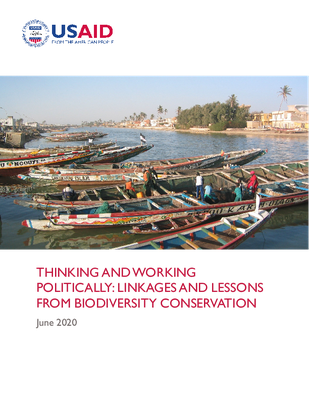Discussion Note 2.0 – Thinking and Working Politically: Linkages and Lessons from Biodiversity Conservation
In 2018, USAID's Center of Excellence on Democracy, Human Rights and Governance published a guide for practitioners on thinking and working politically through applied political economy analysis, and the following year the Office of Forestry and Biodiversity released a first discussion note on thinking and working politically that focused on strengthening political economy analysis in USAID biodiversity programming. This second discussion note is aimed at increasing familiarity with the critical mindset of thinking and working politically, with attention to some of its key concerns, how they are reflected in biodiversity sector activities, and what their implications are for biodiversity programming.
https://biodiversitylinks.org/projects/completed-projects/bridge/bridge-resources/thinking-and-working-politically-linkages-and-lessons-from-biodiversity-conservation.pdf/view
https://biodiversitylinks.org/projects/completed-projects/bridge/bridge-resources/thinking-and-working-politically-linkages-and-lessons-from-biodiversity-conservation.pdf/@@download/image/image.png
File
Discussion Note 2.0 – Thinking and Working Politically: Linkages and Lessons from Biodiversity Conservation
Author(s):
USAID Office of Forestry and Biodiversity
Publication Date: 2020
DOWNLOAD FILE
In 2018, USAID's Center of Excellence on Democracy, Human Rights and Governance published a guide for practitioners on thinking and working politically through applied political economy analysis, and the following year the Office of Forestry and Biodiversity released a first discussion note on thinking and working politically that focused on strengthening political economy analysis in USAID biodiversity programming. This second discussion note is aimed at increasing familiarity with the critical mindset of thinking and working politically, with attention to some of its key concerns, how they are reflected in biodiversity sector activities, and what their implications are for biodiversity programming.



